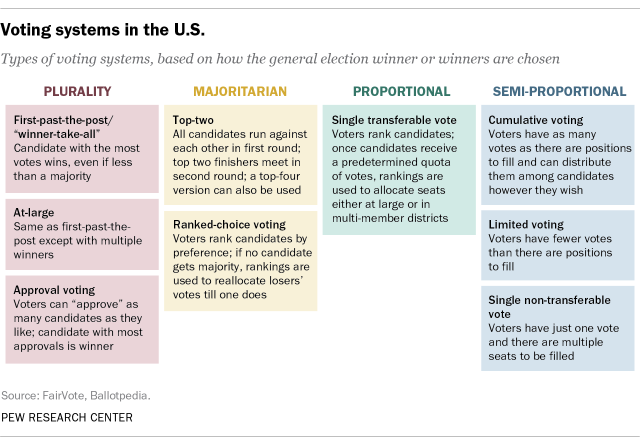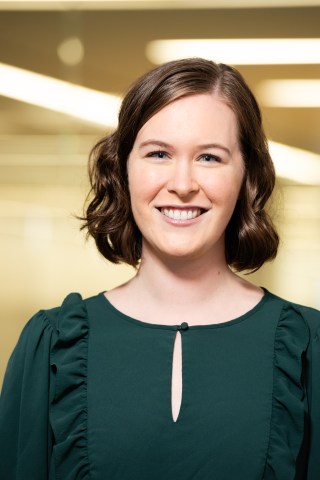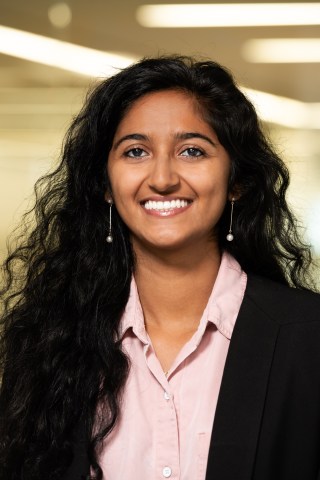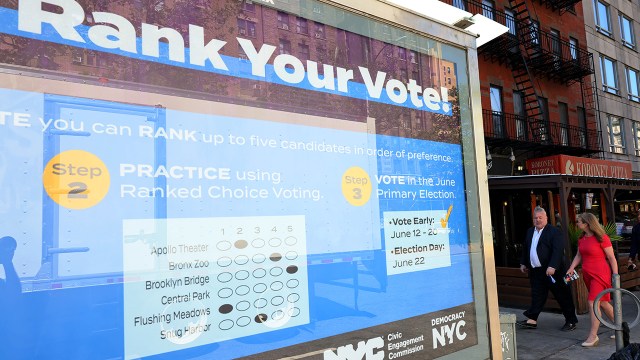
The recent Democratic primary for New York City mayor attracted even more attention than usual, as the nation’s biggest city also became the largest jurisdiction to use an alternative voting system known as ranked-choice voting (RCV).
This is the first time New York has used RCV. In this system, voters can rank more than one candidate in order of preference. (New Yorkers could rank up to five of the 13 candidates on the Democratic ballot. The GOP ballot had only two candidates, so RCV didn’t come into play.)
There’s no single comprehensive source on how U.S. cities, counties, cities, towns, school districts and other local agencies conduct their elections. For this analysis, Pew Research Center relied primarily on information compiled by FairVote, an organization that promotes ranked-choice voting and other innovative electoral arrangements across the country.
To verify and supplement the FairVote information, we consulted Ballotpedia, the National Conference of State Legislatures, dozens of state and local government websites, election reports in local media, and academic and historical studies. In each case, we tried to ascertain when the voting system was adopted and when it was first used; where we could find only one of those years, we assumed the same year for the other. In a few cases, we could find no information on when a city’s voting system was adopted or first used. Those cases were excluded from date-based analyses.
The Center’s analysis included all instances we could find in which a state or local entity has adopted an alternative voting system to elect some or all public officials, either at the primary or general election stage. This included states and locations that currently use alternative methods, and those slated to do so at one of their next elections. Many of the analyzed areas do not use the same voting system in all elections. The analysis also included locations where the legal status of an alternative voting method’s adoption is still pending, such as Amherst, Massachusetts, and Burlington, Vermont. We excluded a half-dozen states and one city that only allow ranked-choice voting for overseas and/or military voters, and even then only in runoffs, on the grounds that most voters couldn’t use the system.
In some places, school districts and local governments that have both adopted an alternative voting method are counted together if they share administrative functions, but in other areas where the two are distinct entities, the school districts are counted separately.
If one candidate receives a majority of first-choice votes, that person wins, and no subsequent rounds are needed. If no one wins a majority of first-preference votes, the last-place candidate is dropped and their votes are reallocated to those voters’ second choices. If there’s still no majority winner, the process repeats with the new last-place candidate being eliminated – and so forth until someone has a majority. (This is why RCV is also called “instant-runoff voting.”)
Advocates for RCV and other alternative voting systems (such as “top-two” primaries, cumulative voting and approval voting) typically argue that they’re more fairly representative than the first-past-the-post (or “winner-take-all”) system that’s standard in most of the United States, and that they can encourage campaigns to appeal beyond their base voters to broader swaths of the electorate. Critics dispute both of those points and claim that unfamiliar and complex voting systems can depress rather than encourage turnout, especially in communities of color.
Most Americans elect their public officials pretty much the same way: There are multiple candidates for a single office (and single-member districts for legislative bodies), a voter casts a ballot for one person, and whoever gets the most votes wins, even if they are well short of a majority. But this “winner-take-all” system is hardly the only way democracy can work. Here’s a look at some of the other systems that have been adopted around the U.S.
Ranked-choice voting (aka “preference” or “instant-runoff” voting): Voters can rank candidates in order of preference. If one candidate receives a majority of first-round votes, that person wins, and no subsequent rounds are needed. If no one wins a majority of the first-preference votes, the last-place candidate is dropped and their votes are reallocated to those voters’ second choices. If there’s still no majority winner, the process repeats with the new last-place candidate being eliminated and those votes reallocated – and so forth until someone has a majority. Used in New York City, San Francisco, Minneapolis and St. Paul, among many other places.
Single transferable vote: A form of ranked-choice voting used mainly for legislative bodies. Candidates run either in multi-member districts or at large, and voters rank them in order of preference. Vote counting proceeds as in RCV, except that once a candidate has received enough votes to guarantee election, any subsequent votes for that candidate are reallocated to the voters’ second choices (assuming they’re still in the running). The goal is to minimize “wasted” votes and have the legislature more closely reflect the electorate’s overall preferences. Used in Cambridge, Massachusetts, among other places.
Top-two primary: Instead of Democrats running in the Democratic primary, Republicans running in the Republican primary and so on, all candidates for a given office run in a single nonpartisan primary. The top finishers (usually two), regardless of party, then meet in the general election. Used for all or nearly all primaries in Washington state and California; in Nebraska for state legislature primaries; and in Louisiana general elections (as it does not have a true primary). Alaska will begin using a “top-four” version in 2022.
Cumulative voting: Also used mainly for multi-member bodies, such as county commissions and school boards. Voters have as many votes as there are seats to be filled, candidates run either at-large or in multi-member districts, and voters can distribute their votes among as few or as many candidates as they wish. By enabling members of minority groups to concentrate their votes on preferred candidates, cumulative voting can make it easier for them to obtain some representation on the council or board. Used in, among other places, Peoria, Illinois, and the Amarillo (Texas) Independent School District.
Limited voting: Similar to cumulative voting except that voters have fewer votes to distribute than there are seats to be filled. Frequently paired with limited nomination (requiring parties to nominate fewer candidates than there are seats), limited voting aims to prevent even a cohesive majority from winning total control of the commission or board. Where voters have only one vote and there are multiple seats to be filled, the system is called the single non-transferable vote. Used extensively in Connecticut to elect local town councils and school boards.
Approval voting: Fargo, North Dakota, became the first U.S. city to use this form of voting last year in its City Commission elections. Seven candidates ran for two at-large seats on the commission. Voters could “approve” as many of those candidates as they liked, and the two who received the most approval votes won the seats. St. Louis used a hybrid of top-two and approval voting in its mayoral primary earlier this year; the two most-approved candidates faced each other in the general election.
New York, with some 5 million active registered voters as of February, is by far the biggest jurisdiction in the U.S. to adopt RCV. Although fewer than 1 million people voted in the primary, turnout was substantially higher than in 2013 (the last competitive primary).
There’s no authoritative, comprehensive source for how many U.S. cities, counties and states employ RCV or other nontraditional voting systems. But according to a new Pew Research Center analysis, such systems have gained popularity in recent years. At least 50 cities, one school board (Albany, California), one county (Benton County, Oregon) and one state (Maine) have adopted RCV or its multi-member cousin, the single transferable vote – including locations that use them currently or are slated to do so at one of their next elections.
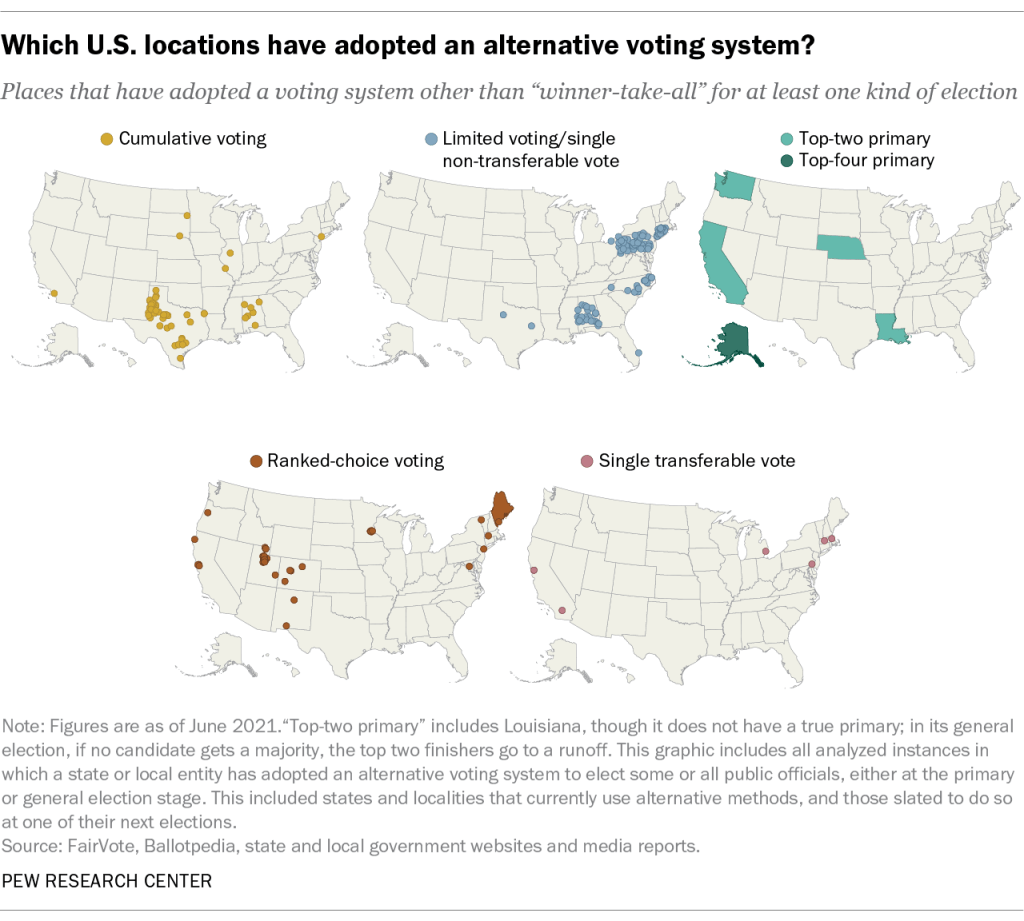
In all, we identified 261 jurisdictions in the U.S. – ranging from the state of California to the Yoakum (Texas) Independent School District – that have adopted some voting method other than the standard single-winner, plurality system most American voters know. (The glossary box in this post has definitions of different voting systems.)
That may not seem like a lot, given that there are tens of thousands of cities, counties, towns and school districts in the U.S., but there’s been a notable uptick in recent years. Since 2000, by our count, at least 63 places have adopted some sort of alternative voting system – 45 of them in 2016 or later, including 23 in Utah under a state-authorized pilot program.
And while in the 1980s and 1990s alternative voting systems were mostly adopted by fairly small communities – often to settle voting-rights lawsuits – more large cities, and even entire states, have engaged in electoral experimentation since the new millennium began.
Maine is the only state that currently uses RCV extensively, starting in 2018 following a voter-passed initiative and considerable political and legal wrangling. RCV is now used in Maine’s primary and general elections for U.S. senators, representatives and president and primaries for governor and state legislators. (RCV was on the books for the 2020 presidential election but didn’t affect the outcome.)
One alternative voting system, the “top-two” primary and its variations, has been adopted by three states since 2004 – Washington, California and Alaska. In this system, all candidates for a given office are listed on the same primary ballot; the top finishers (usually two) go on to the general election, regardless of party affiliation.
Alaska’s new system, adopted last year and scheduled to start in 2022, combines a few alternative voting systems. Candidates for state and federal offices will run in a nonpartisan primary, and the top four will go on to the general election. Then, voters will use ranked choice to decide among the four finalists.
A few other states’ election systems have elements of a top-two primary, too. In Louisiana, all state, federal and local candidates appear on the same ballot in the general election, and if no candidate receives more than 50% of the vote, the top two vote-getters go to a runoff. In Nebraska, all candidates for the unicameral state legislature (but not other offices) appear on the same nonpartisan primary ballot and the top two finishers advance to the general election.
It’s worth noting that many of the analyzed states and locations have not adopted the same voting system in all elections. For this analysis, we included all instances we could find in which a state or local entity has adopted an alternative voting system to elect some or all public officials, either at the primary or general election stage.
It’s become common for voters themselves to push for new voting systems – either directly via initiative, by approving the change in a referendum, or by expressing support for the proposal in an advisory vote prior to its official adoption. By our count, 25 of the 63 states and locations identified as having adopted an alternative voting system since 2000 (40%) did so pursuant to a public vote.
What people think of today as the standard American voting system – candidates running for a single office, with the winner being whoever gets more votes than anyone else – wasn’t always the standard earlier in the nation’s history.
Until the 1840s, for instance, several states elected their congressional representatives not by district but via at-large “general tickets,” where voters could cast as many votes as there were House seats, but could vote for each candidate only once. What usually happened was voters cast a “straight ticket” vote for a party’s entire slate of nominees, and a single party would win the state’s whole delegation. Despite an 1842 law purportedly banning the general ticket, it lingered for decades – as recently as 1933, five states used it – until it was definitively outlawed in the late 1960s.
From 1870 to 1980, the Illinois House of Representatives was elected by cumulative voting. The state was divided into three-seat districts, and voters had three votes they could distribute among one, two or three candidates.
Pennsylvania has used “limited voting” – a system designed to prevent the minority party from being totally locked out of power – in many counties to elect county commissioners since an 1871 change to its constitution. In that system, voters have two votes for three seats. Connecticut laws in 1949 and 1959 combined to create a limited voting system for most local boards and commissions, which is why 42 such boards and town councils in the Nutmeg State use it to this day.
In the first decades of the 20th century, the Proportional Representation League lobbied for cities to adopt the single transferable vote (STV) system. (STV, a ranked-choice system used to elect legislators from multi-member districts, aims to ensure representation in proportion to a group’s, party’s or candidate’s share of the vote.) Two dozen cities eventually adopted STV, including New York City from 1936 to 1947, but by 1962, all but one had repealed it, in part due to fears that STV empowered “undesirable” racial and political minorities – that is, Black Americans and Communists. (Cambridge, Massachusetts, is the only place that adopted the STV system in that era that retains it to this day.)
Over the past two decades, RCV has been the most widely adopted alternative voting system. Of the 63 states and locations the Center identified as having adopted a voting alternative since 2000, 46 have gone with RCV. They include Minneapolis and St. Paul, Minnesota, along with several of their suburbs; San Francisco and Oakland, Calif., and several smaller Bay Area communities; Salt Lake City and 22 other cities and towns in Utah; and Santa Fe and Las Cruces, New Mexico.
The ranks of places adopting RCV seem likely to grow. In 2020, Virginia enacted a law allowing cities to opt in to RCV starting next month (though the system likely won’t be used until 2022 or later). And just this week, Colorado Gov. Jared Polis signed a bill intended to make it easier for the state’s municipalities to adopt RCV elections. (Currently four have RCV on the books, though only three have used it.)
